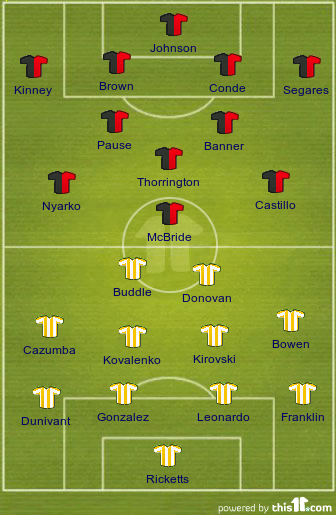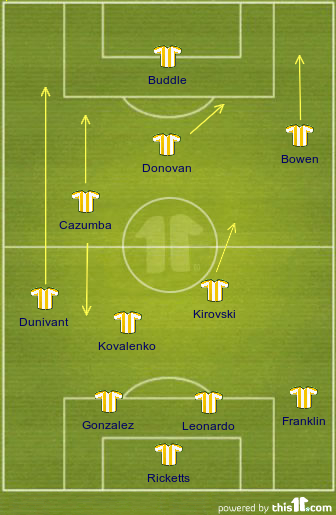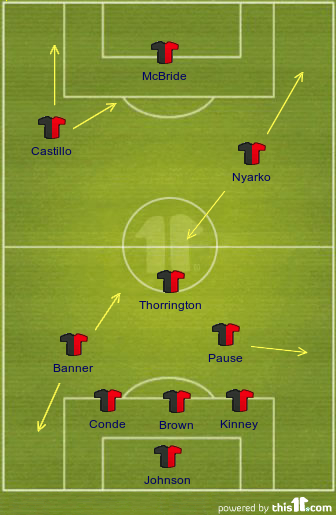
The starting lineups.
A slow-burning Major League Soccer game ignited with two late goals, and the Chicago Fire were unlucky not to come away with all three points after a resounding tactical victory. After an even opening twenty minutes a red card for Gonzalo Segares put the Fire on the back foot. Chicago coach Carlos de los Cobos then took a tactical gamble – and Los Angeles played right into his hands.
The recent trend of 4-2-3-1 has not passed MLS by, although in this game Chicago’s interpretation of it was somewhat dynamic and could perhaps be described as closer to 4-3-3. Brian McBride was the lone striker, with Patrick Nyarko and new Designated Player Nery Castillo starting in wide forward positions and John Thorrington as the most advanced of the three central midfielders. Logan Pause and Mike Banner took up more reserved midfield roles.
The Galaxy’s formation was fascinating, and reminiscent of Dunga’s Brazil in that both hinged on an unusually lopsided midfield. Edson Buddle was up front, with Landon Donovan just behind. Tristan Bowen was almost permanently stationed in a very advanced position on the right flank while Alex Cazumba, the left-sided midfielder, shifted inside a little and allowed left-back Todd Dunivant to do most of the work out wide. Jovan Kirovski and Dema Kovalenko, two experienced MLS players, provided the shield in front of the defence, and had little attacking brief to speak of.

The Galaxy's lop-sided midfield.
Left Back in the Dressing Room
The early stages of the match were fairly unremarkable, rather cagey and with each side sounding the other out, as is to be expected in such as important game. Just before the first-half’s midway point, however, Gonzalo Segares was shown a straight red for elbowing Galaxy defender Leonardo. Unsurprisingly, this produced the turning-point of the game – not the resulting penalty, a weak Donovan effort comfortably saved by Sean Johnson, but rather the huge gamble taken by Carlos de los Cobos.
The Fire coach did not respond to the sending-off by sacrificing, say, Castillo or Nyarko for another defender (in fact the Fire’s first substitution was not until the 68th minute). Instead he effectively gave Mike Banner the task of performing the defensive functions of the absent Segares while also continuing to fulfil his own role as a central midfielder. The front three was retained, meaning that Chicago could still use the width of the pitch going forward. In fact the only defensive change was John Thorrington limiting his forward running, giving the Fire a very compact, deep-lying midfield - though Nyarko also helped out by dropping back and carrying the ball out of midfield when Chicago regained possession.

The Fire coped with Segares' sending-off by using Mike Banner in a dual defensive and midfield role.
Banner Flies as Fire Extinguish
Given Chicago’s narrow 3-3-3 formation, the task for the Los Angeles Galaxy became to use their numerical advantage to drag defenders out of position. As much as the Fire defence and Mike Banner in particular were excellent, Galaxy coach Bruce Arena played right into their hands. The Los Angeles attacks were mostly focussed down the right side, where it quickly became apparent that Banner had the better of Tristan Bowen. Bowen also suffered from a lack of support – the right-back and Chris Hughton lookalike Sean Franklin didn’t venture forward at all despite the acres of space left in wide midfield positions by Segares' absence.
Few attacks came down the left, where Todd Dunivant tirelessly dominated the touchline all game while left-midfielder Alex Cazumba shifted infield and pursued a useful if unspectacular shuttling role. When the Galaxy did attack down this side it usually resulted in a corner, a goalscoring chance or at least a meaningful foray into Chicago territory. That Arena failed to recognise the usefulness of the Dunivant-Cazumba partnership is curious - although trying to exploit the apparently vacant left-back spot makes sense, a better strategy might have been to use Bowen as a decoy - his advanced position on the right flank keeping the defence stretched while attacks are concentrated down the left.
The Hit Striker Guiding the Galaxy
Obviously, LA’s success or failure was always likely to depend to some degree on the performance of Landon Donovan. Penalty miss aside, the US international was largely kept quiet. Donovan, deployed just off Edson Buddle, generally drifted slightly to the right and was always looking to make runs into the box. Though his quality showed with some nice touches to bring others into play, he couldn’t provide an incisive pass to unlock the defence.
Donovan may have been better served dropping further back – the Fire sat so deep that there was plenty of space to dictate play from midfield and perhaps draw a Chicago player out of the rigid defensive line. It was telling that, when Mike Magee was brought on, the presence of two orthodox strikers occupying the centre-backs gave Donovan much more freedom to play in front of the defence and pick out the right pass. For the majority of the match, however, Chicago limited space between the lines very well, and Donovan was largely subdued as a result.
Stand back, I’m about to compare Los Angeles Galaxy to Barcelona
Dominating possession is too often equated with dominating the game. In last season’s UEFA Champions League semi-final second-leg, for instance, Barcelona had the lion’s share of the ball while ten-man Internazionale were quite happy to concede the ball and focus on controlling space. Barça didn’t dominate the game and never really looked like proceeding to the final, despite spending the majority of the match in Inter’s half. Mourinho’s tactical masterclass was such that his side could be said to have dominated that match.
It’s an extreme example, and one obviously taken from a much higher level of the game, but some comparisons are valid as Chicago tried to overcome their numerical disadvantage in a similar way. It could therefore be said that, in some respects, the Fire dominated this game. It certainly did not seem a particular injustice when Collins John curled a free-kick inside the far post and seemed to have snatched a victory for the home side, since Chicago had done all they could – restricted the Galaxy’s chances, stifled their best players and taken an opportunity when it fell to them. Although the towering Omar Gonzalez headed a late equaliser from a Donovan corner the tactical victory was still Chicago’s – showing that, in the aftermath of a sending-off, a demonstration of tactical versatility can be a more effective response than a knee-jerk substitution.
Really interesting discussion of formations and how they coped with a sending off. Do you think Manchester United's current formation is similar to the Brazilian lopsided 4-4-2? To me it seems Nani is playing the advanced winger role (that Ronaldo used to play) while Giggs on the other side tucks in and plays often as a third central midfielder. Evra is the more attacking of the fullbacks by a long way - would love to see a heat map of a typical game.
ReplyDeleteThen again, you could talk about formations for so long that they all almost blend into one. For example you mention A 4-2-3-1 that is dynamic and becomes a 4-3-3 - but you could descibe either as a 4-5-1 when defending, or a 4-4-2 when the attacking midfielder advances, or even a 4-1-2-1-2-1!
Are you inspired by Zonal Marking by any chance?